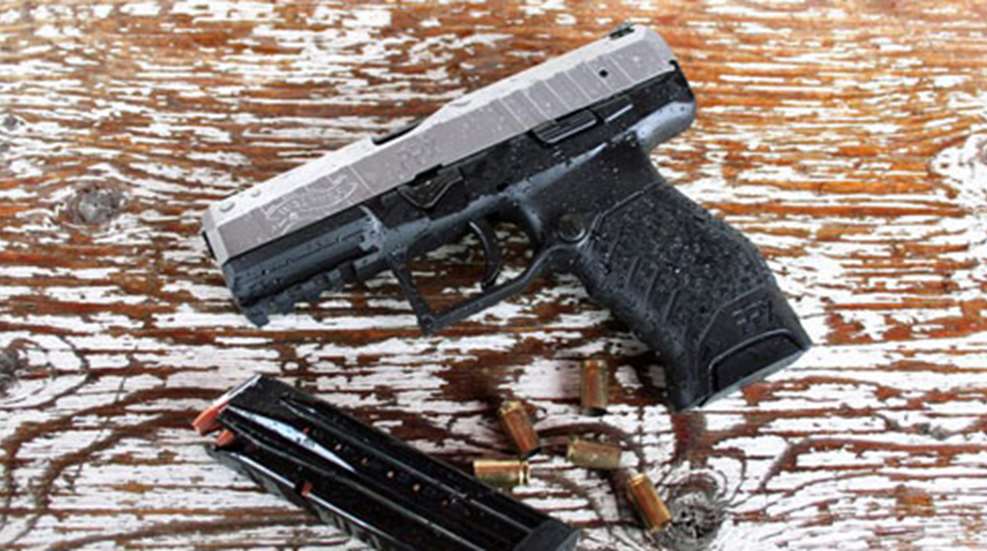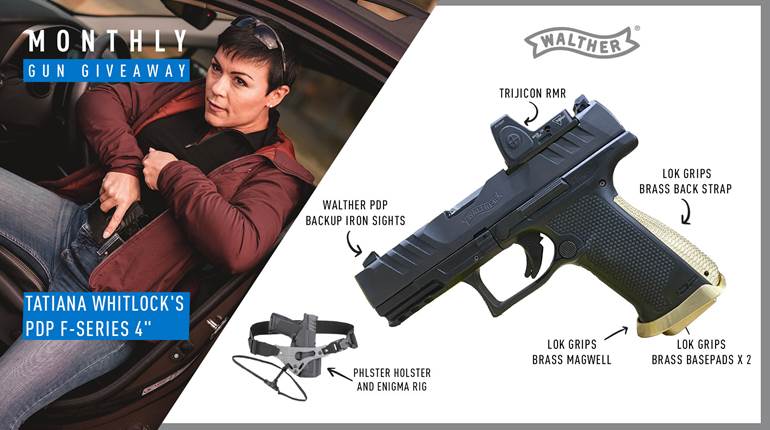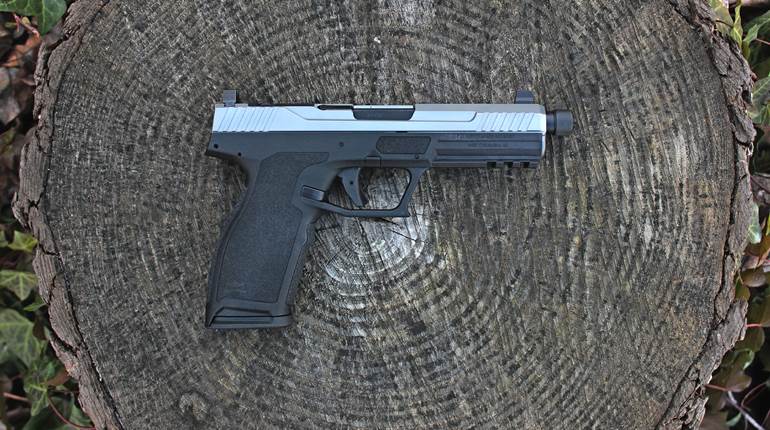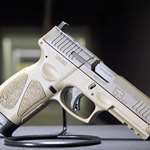
One gunmaker who's been around the block is Walther. Founded by Carl Walther in 1886, this manufacturing company has gone through many changes over the years but it's still here and doing well. Walther has been careful to keep up with the times. Almost two decades ago, the company entered the polymer-framed striker pistol market with the P99. In 2013, they continued to expand its line of polymer pistols with the release of the affordably priced PPX, available in 9 mm and .40 S&W.
The PPX is a full-sized semi-auto pistol that is 7.3-inches long, 5.6-inches high and 1.14-inches wide, weighing in at 27-ounces empty. It features a slide and barrel treated with a Tenifer finish for increased durability and resistance to dirt and moisture. The beveled, stainless-steel slide has front and rear slide serrations and is topped with low-profile metallic three-dot combat sights. The rear sight is drift adjustable for windage.
The barrel contains traditional land-and-groove rifling with a loaded chamber view port. It is supported by a recoil assembly consisting of a single flat-wire spring captured on a one-piece polymer guide rod. The barrel is unusual because of its three-piece design (consisting of the barrel, breech block and feeding ramp) instead of being cut from a single block of material like most pistol barrels. Walther touts this barrel as being less likely to deform than one-piece barrels, which may or may not be true, but it looks as if they were striving for a way to cut costs as well.
The ignition system for the PPX is described by the company as a pre-cocked, hammer-fired system. In practice, this means the exposed hammer is moved to a partially cocked position, much like the striker of a striker-fired pistol, when the slide is cycled to chamber the first round from the magazine. The spur-less hammer rests flush with the rear of the slide when cocked, and leans forward into the slide when uncocked. As the slide cycles with each round fired, the hammer is reset to a partial-cock position. This pistol does not have a second-strike feature, meaning if the hammer falls onto a faulty round, the slide will need to be cycled to reset the hammer.
The PPX has no external safety levers or buttons. It does contain two internal drop safeties plus a firing pin block safety. The smooth-faced polymer bow trigger has rounded edges and provides plenty of finger room along the front surface. It's housed in a roomy under-cut trigger guard that should accommodate gloved fingers. The front of the trigger guard provides a flat textured finger rest. The PPX is listed by Walther as having a factory trigger pull of 6 pounds, 8 ounces. The pistol used for this test arrived with a smooth 4-pound, 4-ounce trigger, according to a digital trigger gauge.
The gun's controls are located on the left side of the frame, including the slide catch, the round magazine release button and the take-down lever. The magazine release is partially shrouded underneath by an extension of the frame to protect it from unintentional bumps and it is reversible for left-handed shooters. A molded-in 1913 Picatinny accessory rail, which is nearly 2-inches long, provides plenty of real estate for a variety of light and laser modules.
The grip is treated on all four sides with a texturing that is effective without being abrasive to hands or clothing. The front of the grip has finger grooves with a pronounced flair at the base, with the fixed backstrap featuring a distinctive angled shape. It’s a grip configuration that feels good in the hand. Should you have need of it, a lanyard loop is located at the bottom of the grip's backstrap.
The strong, cleanly constructed, blued-steel, 16-round magazines are made by Mec-Gar of Italy. They are easy to take apart for cleaning and the bases fit flush with the grip frame when seated in the pistol. Some pistols, like the Glock, have a cutout at the base of the grip so that a malfunctioning (i.e. stuck) magazine can be manually extracted from the grip frame. For the PPX, the flush-fit magazine base plates have gripping surfaces on the left and right sides, just in case the magazine needs to be pulled out.
Field stripping the PPX is a simple process that does not require the manual maneuverings of some pistol designs. Start by removing the magazine and verifying the chamber is unloaded. Lock the slide into the open position using the slide catch. Rotate the takedown lever, located just above the trigger on the left side, so that it points down toward the trigger. While holding the slide, release it from the slide catch and move it forward off of the frame. Remove the recoil assembly and the barrel from the slide and the pistol is ready to clean.
One of the first things folks want to know about 9 mm pistols these days is if they can handle +P ammunition. Cartridges rated as +P operate at pressure levels that exceed the SAAMI limits specified for that particular round. Some gun companies come right out and say yes, go ahead and shoot +P rounds if you like, while others tell customers to avoid them completely. Walther takes the middle ground in the PPX owner’s manual by stating that +P loads will cause the gun to wear more quickly and require more frequent servicing. However, Walther is explicit in stating that +P+ rated ammunition, extremely hot loads, should not be used at all in this gun. For this range test, the PPX was test fired with standard pressure loads.
At the range, the PPX acquitted itself nicely. It ran reliably with all of the full-metal-jacket and hollow-point ammunition it was fed with no malfunctions. The trigger was smooth, light and comfortable to work. Many double-stack grip frames can feel fat or overly large but Walther provides a more hand-friendly grip than some. Empty magazines ejected vigorously when the magazine release was pressed, and loaded magazines snapped snuggly into place when loaded. The sights were easy to see and quickly acquired for a clear sight picture. Overall, it was a comfortable pistol to work during off-hand shooting.
Formal accuracy testing was conducted from a benchrest firing five, five-shot groups into targets set at 25 yards. Individual groups ranged from 3.41 inches to 4.49 inches in size. The best group average of 3.79 inches was produced using Hornady 115-grain Z-Max ammunition. Winchester's 147-grain PDX1 Defender load averaged 3.91 inches, followed by Federal's American Eagle 124-grain full-metal-jacket load at 4.12 inches.
The Walther PPX represents one of those good opportunities to purchase a defensive pistol with a full set of features at an "entry” level price. This 9 mm produces a perfectly manageable level of felt recoil, the sights are easy to see and the grip is comfortable, even for smaller hands. This pistol is a good option for both inexperienced and seasoned shooters who are looking for a full-sized semi-auto for comfortable shooting at the range or for personal protection.
Manufacturer: Walther Arms, Waltherarms.com
Model: PPX (2790122)
Action: Pre-Cocked Hammer Fired Semi-Auto
Caliber: 9 mm (Tested), .40 S&W
Slide: Tenifer-Coated Stainless Steel
Frame: Black Textured Polymer
Accessory Rail: 1913 Picatinny Mil-Standard
Sights: Three-Dot Combat
Trigger: 6.5 lbs. (Listed)
Barrel Length: 4”
Overall Length: 7.3”
Height: 5.6”
Width: 1.14”
Weight: 27 ozs.
Capacity: 16 +1 Rounds
Twist: 1:9.84" RH
Rifle Grooves: 6
Accessories: Hard Case, Two Magazines, Lock, Owner's Manual
Suggested Retail Price: $449 - $499






































